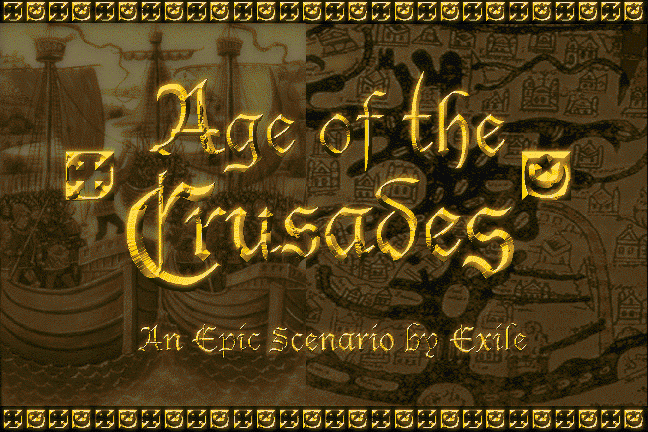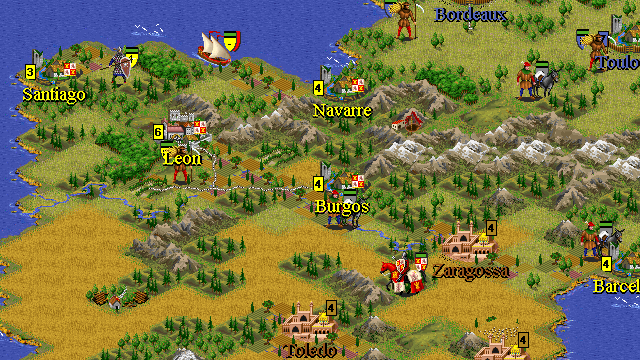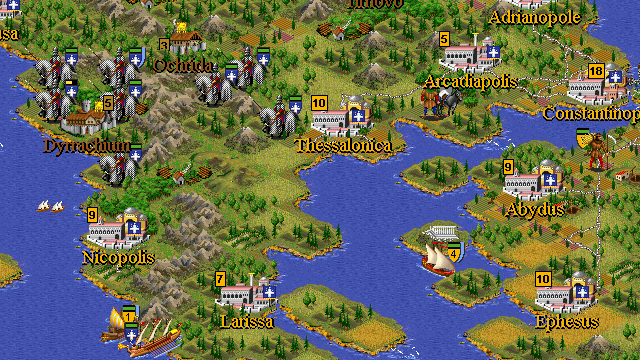The Age of Crusades
A scenario for Civilization II: Multiplayer Gold Edition by Exile.
Description
"Be it known to you that we have certainly conquered for Our Lord two hundred cities and castles. May our Mother Church in the west rejoice that she has borne men who have won for her such a glorious name and have succored the Church in the east in such a Marvelous fashion."
- - Anselm of Ribemont, writing to Manasses, archbishop of Reims, November 1097 during the siege of Antioch.
The Crusades are remembered for their martial accomplishments, the victories and defeats. The names of Saladin and Richard the Lion-hearted are familiar, but how many recall the Byzantine Emperor Basil II Bulgaroctonus, who put out the eyes of 14,000 captive Bulgars? How many recall Zengi esh Shami, Emir of Mosul and conqueror of the empire eventually inherited by Saladin and his Ayyubid heirs? How many can speak of the Lion Hero, Alp Arslan, Sultan of the Seljuk Turks, and tell the story of his climb up the glistening stair of empire? And what of the stories of the men who fought in Iberia and Sicily, Georgia and Apulia, and all along the coastlands of the western countries? The Crusades, as exciting as they were and have become, were only one facet of the unique historical mosaic that was the medieval Mediterranean. This scenario attempts to recreate that colorful and dynamic pattern of shifting nations, of rising and falling empires, and of the bustle heralding the rebirth of trade.
After half a millennium spent in a dark age, Europe finally emerged at the beginning of the eleventh century. For quite a few centuries, the political and ecclesiastical lights in Europe had been buffeted repeatedly, threatening finally to go out. Yet as the year 1000 AD came, things improved. The agricultural potential of the north European plain was scarcely realized, and a period of warmer weather, and consequently longer growing seasons, assisted by new, more sturdy iron plowshares, created a population boom in the northwest of the continent. Over the next two centuries, the Franks and vikings would become the source for military manpower all across the oecumene.
In Spain, Frankish knights swelled the ranks of the armies of Leon and Castile, and one of the foremost captains of the first crusade, Raymond of Toulouse, earned his reputation fighting there. Normans from the northwestern part of the Frankish realm carved out a border kingdom in southern Italy, fought the Byzantines off, and would soon expel the Saracens from all of Sicily. Horsed warriors from France conquered Britain in 1066, fighting with Scandinavian groups over the Aenglish crown. During the period, easterners referred to all western fighting men as "Franks." Norse, Dane, and Varangian raiders had struck repeatedly at the southern lands in the previous century, from Cadiz to Constantinople, but the attacks were coming less often after the turn of the millennium. The Italian city states grew from a collection of unremarkable small towns, none of which could boast 15,000 inhabitants, into hubs of maritime commerce and trade, dozens with populations in the tens of thousands. If northern Europe was exporting soldiers, Italy was exporting, and importing, anything that would pay. Northern Italy was situated near an abundance of timber, had a good coastline, and was experiencing the same population boom as in Scandinavia and the north European plain. People from the countryside streamed into the cities of Lombardy, Tuscany, and the Romagna. These cities dominated the carrying trade, the bulk trade, and the luxury trade in the medieval Mediterranean during their heyday. The only competitors they had were each other, and the banking houses in those cities rivalled and outbid the incomes of kings and nations. The Italians became the bankers for a continent. But while European populations grew, the times were turbulent for the lands of west Asia; Byzantine Anatolia and the Arab levant.
Wave after wave of Turkic invaders rode across the vast steppe from the unguessable east and overcame the nations that lay in their path. There were the Pechenegs and Khazars, Turks who had come in the first great migration in the 7th and 8th centuries, and there were the Cumans and Seljuks, both offshoots of the Ghuzz Turks, the former moving north, the latter moving south, of the Black Sea. The Turkic migrations continued as other Turkoman groups wandered and fought their way out of Asia and into the rich and fertile lands of the ancient civilizations. In the end there were the Mongols, the final empire builders, the horsebowmen of the broad steppe, who built the largest land empire the world has ever seen. These were fiery times, times of blood and battle, but also times of expansion and growth, learning and piety and trade. This era marked the emergence of a resurgent Europe, as it fought its way clear of the age of darkness and into the AGE of CRUSADES.
Screenshots
Downloads
Scenario Files (550 kB)
Sound Files (2.25 MB)


